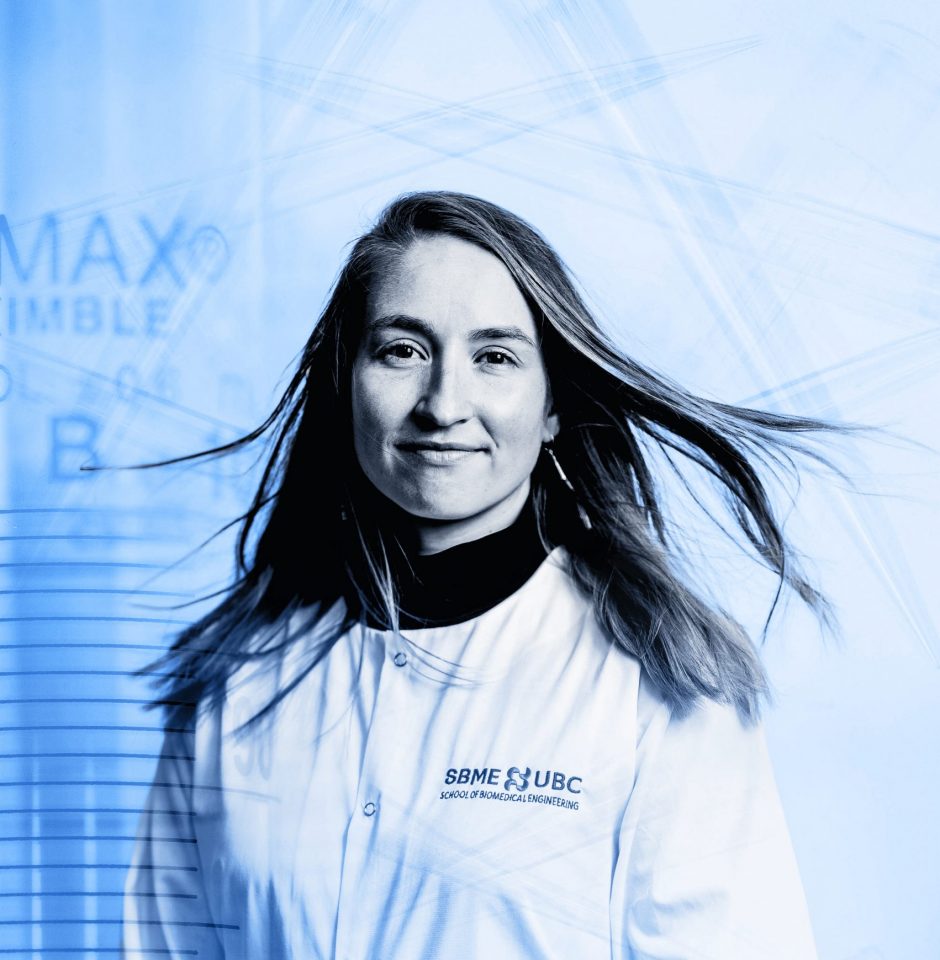
FEATURE STORY
How a million doses in a single test tube can save the world
From cancer treatments to vaccines, Dr. Anna Blakney is working to unlock the enormous potential of mRNA.
When most people think about mRNA, they imagine the Pfizer-BioNTech or Moderna jab: the chill of the alcohol swab, the sting of the injection, the flood of relief that comes with knowing you are protected from the virus.
When Dr. Anna Blakney thinks about mRNA, her mind immediately travels to the post-COVID future.
“What if you could produce enough vaccine to immunize the entire population of Canada against a wide range of diseases — and all you needed was a single lab workbench? With mRNA, it’s possible,” Dr. Blakney says.
With her team at the University of British Columbia (UBC), Dr. Blakney is helping to unlock the vast potential of mRNA technology — now synonymous with the COVID-19 vaccine, but with much broader applications and endless possibilities — for the prevention and treatment of everything from yellow fever to cancer.
Urgent lessons from the global pandemic
The need for nimble, scalable, cost-effective treatments and prevention tools has never been more urgent.
“The pandemic has radically changed our understanding of what’s possible, both good and bad,” Dr. Blakney, an assistant professor at UBC’s School of Biomedical Engineering and Michael Smith Laboratories, says.
She speaks from experience. Before joining UBC, Dr. Blakney was part of the Imperial College London team that helped develop the Pfizer-BioNTech vaccine. Watching the virus spread across the globe while the team worked to meet next-to-impossible deadlines was eye opening, to say the least.
“The success of the vaccines showed us that, together as an international community of scientists, we can solve enormous health challenges in an incredibly short time frame,” she says. “But the spread and devastation of the virus has also demonstrated how vulnerable we are, globally, to mass outbreaks of disease.”
Dr. Blakney brought this sense of urgency with her to UBC’s biomedical innovation hub, where she and her team are developing self-amplifying RNA, a technology that builds on the existing mRNA vaccine platform.
Vaccine equity for the world
Dr. Blakney’s research uses modified RNA that replicates itself within cells, so patients need only a tiny dose of vaccine to generate a robust immune response to the target pathogen.
Self-amplifying RNA is 100 times more efficient than the mRNA used in the current vaccines, and equally safe.
“You can imagine how this will accelerate our ability to respond to new and highly contagious diseases, or to mutations of existing ones, like the COVID-19 omicron variant,” she explains.
“The advantage of mRNA is that you don’t need live cells. You could make enough vaccine doses for every Canadian in three to four months.”
– Dr. Anna Blakney
And because mRNA vaccines are synthetic, they are already much more readily scalable than traditional vaccines.
“The advantage of mRNA is that you don’t need live cells. In theory, you could make a million doses of vaccine in a single test tube, and enough for every Canadian in three to four months,” she says. That’s an astonishing 38 million doses.
The impact on public health would indeed be enormous, making immunization at the population level safer, faster and more cost-effective for the entire world — so that people everywhere, regardless of identity or circumstances, can have the chance to live healthy, productive lives.

From COVID-19 to cancer and beyond
And COVID-19 is just the beginning. What makes experts like Dr. Blakney optimistic about the future is mRNA’s revolutionary flexibility. It can be adapted to fight just about any disease.
“MAT (monocolonal antibody treatment) costs upwards of $10,000 and requires an IV infusion in a clinical setting. What if we could use self-amplifying mRNA to make the same therapy much more affordable and accessible via a simple, intra-muscular injection? That’s our goal,” she says.
mRNA technology has the potential not just to make existing treatments like MAT more effective and accessible, but to form the basis of entirely new ones, from immunotherapies to gene therapies and beyond.
In the same way that the current mRNA vaccines train the immune system to make antibodies to protect against the spike protein found on the surface of the COVID-19 virus, new vaccines can be developed to recognize a protein on the surface of a cancer cell, a drug-resistant tuberculosis cell, or the yellow fever virus, generating the needed immune response.
And because mRNA can be used to encode almost any protein, the technology could be deployed in therapies for diseases like cystic fibrosis, which are caused by missing or malformed proteins.
Ultimately, the future for mRNA is bright, and there’s nowhere Dr. Blakney would rather be.
“We’re creating the technology we need to fight the next big pandemic — and perhaps one day even solve the riddle of diseases like cancer.”
– Dr. Anna Blakney
“When I look around, I see UBC researchers making important breakthroughs and I see UBC spin-off biotechs developing state-of-the-art biomanufacturing facilities in the heart of Vancouver,” says Dr. Blakney.
Since the beginning of the COVID-19 pandemic, British Columbia has emerged as a global powerhouse of biomedical and life sciences research and innovation, with Canada’s largest and fastest-growing biotechnology companies driving economic growth and health care advances.
“We have the intellectual firepower. We’re building the infrastructure. We’re creating the technology we need to fight the next big pandemic — and perhaps one day even solve the riddle of diseases like cancer. It’s very, very, exciting,” she says.


